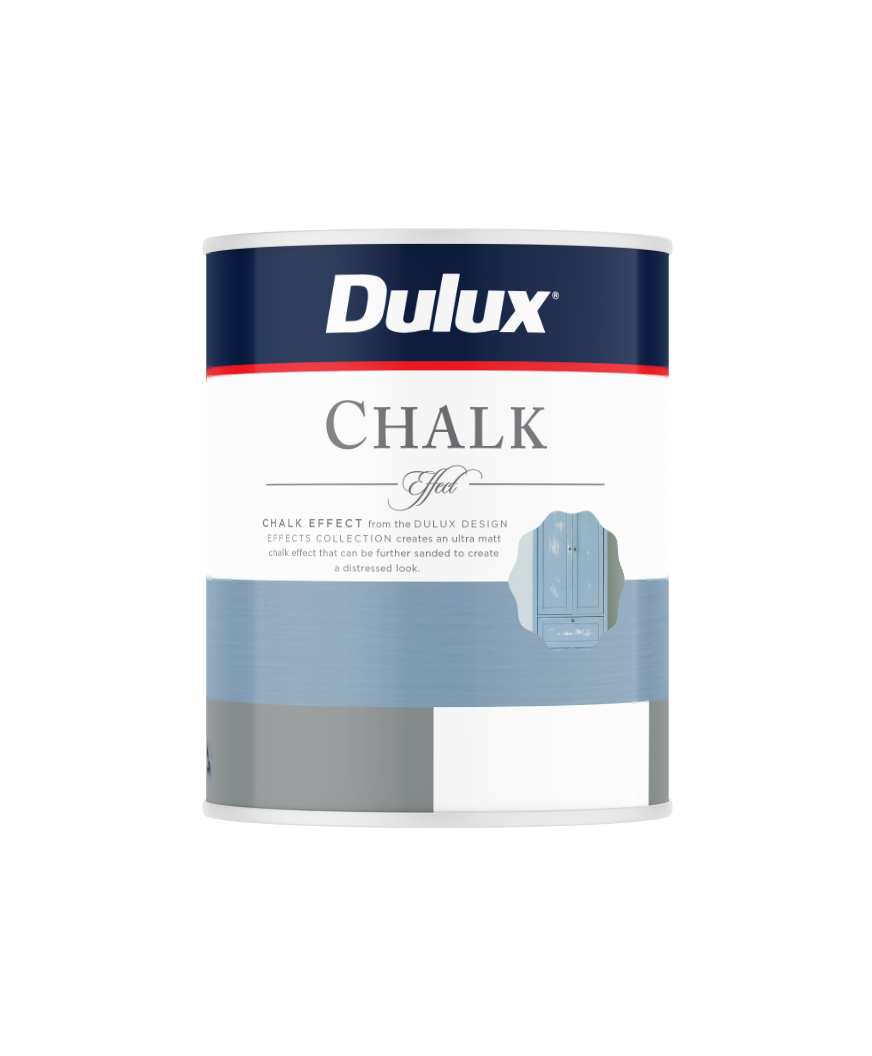
About Chalk
Upscale or refresh your furniture and walls with a softer touch using Chalk Effect from the Dulux Design Effects Collection.
Chalk Effect creates an ultra matt chalk effect that can be further sanded to create a distressed look.
Downloads
Application
At a glance
- Can be tinted to any white base colour
- Combine colours for an individual look
- Sand for a distressed look
- Protect finish for longer with Design Effects Clear Coat
Areas to use
Performance guide
Chalk Effect is suitable for walls, trims, furniture or home accessories.
Not suitable for high traffic table tops or surfaces.
Surfaces
• Previously painted surfaces
• Plasterboard
• Brick
• Cement sheet
• Set plaster
• Metal surfaces
Previously Painted Surfaces
Surface must be clear, dry and free from dust, oils and grease.
Unpainted surfaces:
• Apply one coat of Dulux 1Step® Prep Water Based Primer, Sealer & Undercoat, following directions on pack.
• Use Dulux 1Step® Prep Oil Based Primer, Sealer & Undercoat for tannin-rich timber.
Brush, roller
• Stir well with a broad flat paddle using an up and down scooping action.
• Apply two coats of Dulux Design Chalk Effect using a good quality brush to cut in and a short nap roller in good condition for rolling.
• Allow a minimum of two hours dry time between coats.
• Allow the final coat to dry and cure for seven days before sanding.
• Chalk effect can be left in the current ultra matt appearance or further sanded to create a vintage distressed look.
One colour distressing:
• To distress, use a fine-medium grit sand paper (P240-P180) and lightly sand in one direction.
• Other grit papers can be used to achieve the desired finish.
• For an authentic distressed look, sand areas of the surface where wear is most likely to naturally occur.
Two-colour distressing:
• Choose your Dulux Design Effects Chalk colours.
• Apply two even coats of the first colour.
• Apply one coat of the second colour.
• Wait two hours before sanding or distressing.
For greater protection on furniture or home accessories follow with Dulux Design Effects Clear topcoat.
Please note: Clear topcoat may further increase the gloss lightly and darken the effect colour slightly.
Unused paint
Do not pour leftover paint down the drain.
Unwanted paint should be brushed out on newspaper and allowed to dry, and then disposed of via domestic waste collections.
For more information on responsible disposal of paint and packaging visit paintback.com.au or painttakeback.co.nz
For more information visit painttakeback.co.nz
Empty paint containers
Leave empty paint containers open in a well-ventilated area to dry out. When dry, recycle the container via steel can recycling programs.
Disposal of empty paint containers via domestic recycling programs may differ between local authorities. Check with your local council first.
Do not reuse container unless thoroughly decontaminated.
For more information on responsible disposal of paint and packaging visit paintback.com.au or painttakeback.co.nz
Make confident decisions about your project needs with support from our wide network of colour and product specialists, tools, programs and apps — or chat to one of our expert consultants now.

Imagining how a space will feel in a new colour scheme is hard. Save time and gain colour confidence the smart way with personal guidance from an expert Dulux Colour Consultant.
Learn more-->Have you got the vision but need some help with application? Connect with the right local painter to suit your needs.
Find a painter-->
